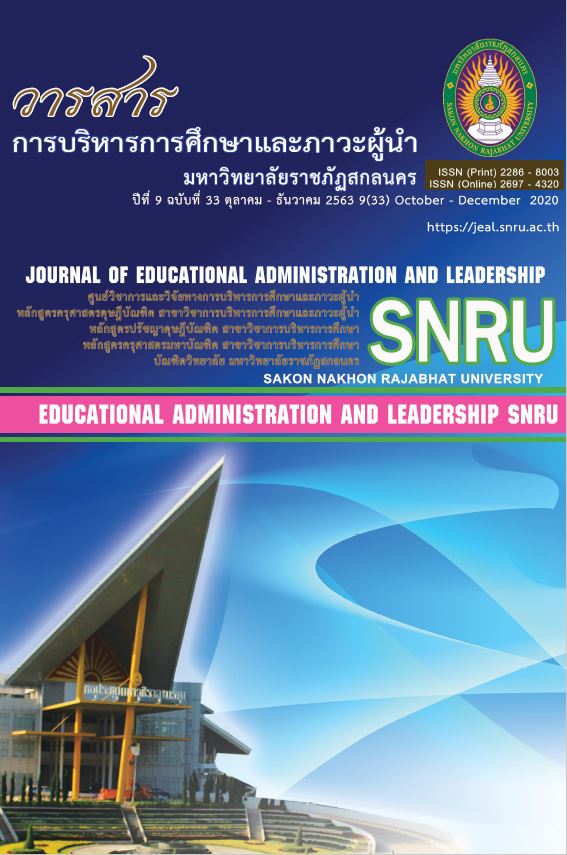

การพัฒนารูปแบบการเรียนรู้แบบผสมผสานด้วยวิธีการเรียนรู้แบบนำตนเอง รายวิชาการวิจัย เพื่อพัฒนาการเรียนรู้ สำหรับนักศึกษาสายครู
The Development of Blended Instructional Model Based on Self-Directed Learning Method in Research for Educational Development Course for Student Teachers
ผู้แต่ง
เพลินพิศ ธรรมรัตน์
Author
Ploenpit Thummarat
บทคัดย่อ
การวิจัยครั้งนี้มีความมุ่งหมายเพื่อ 1) พัฒนารูปแบบการเรียนรู้แบบแบบผสมผสานด้วยวิธีการเรียนรู้แบบนำตนเอง รายวิชาการวิจัยเพื่อพัฒนาการเรียนรู้ สำหรับนักศึกษาสายครู 2) ศึกษาผลการทดลองใช้รูปแบบการเรียนรู้แบบผสมผสานด้วยวิธีการเรียนรู้แบบนำตนเอง รายวิชาการวิจัยเพื่อพัฒนาการเรียนรู้ สำหรับนักศึกษาสายครู วิธีดำเนินการวิจัย ประกอบด้วย 3 ขั้นตอน ได้แก่ 1) การพัฒนารูปแบบการเรียนรู้ 2) การสร้างเครื่องมือในการเก็บรวบรวมข้อมูล 3) การทดลองใช้รูปแบบการเรียนรู้ กลุ่มตัวอย่างที่ใช้ในการวิจัยครั้งนี้ คือ นักศึกษาระดับปริญญาตรี คณะครุศาสตร์ มหาวิทยาลัยราชภัฏสกลนคร ที่ลงทะเบียนเรียน รายวิชาการวิจัยเพื่อพัฒนาการเรียนรู้ ภาคเรียนที่ 2 ปีการศึกษา 2562 จำนวน 2 หมู่เรียน จำนวน 50 คน เป็นกลุ่มทดลอง จำนวน 26 คน กลุ่มควบคุม จำนวน 24 คน ได้มาจากการสุ่มแบบกลุ่ม ได้มาจากการสุ่มแบบกลุ่ม (Cluster Random Sampling) เครื่องมือที่ใช้ในการวิจัย ได้แก่ 1) แบบทดสอบวัดผลสัมฤทธิ์ทางการเรียนรายวิชาการวิจัยเพื่อพัฒนาการเรียนรู้ 2) แบบวัดคุณลักษณะการเรียนรู้แบบนำตนเองและ 3) แบบสอบถามความพึงพอใจ การวิเคราะห์ข้อมูลใช้การวิเคราะห์เชิงปริมาณและเชิงคุณภาพ สถิติที่ใช้ในการวิเคราะห์ข้อมูลได้แก่ ความถี่ ร้อยละ ค่าเฉลี่ย ส่วนเบี่ยงเบนมาตรฐาน และทดสอบค่าทีแบบ One Sample, Dependent Samples และ Independent Samples การวิเคราะห์ข้อมูลเชิงคุณภาพใช้การวิเคราะห์เนื้อหา (Content Analysis)
ผลการวิจัย พบว่า
1. รูปแบบการเรียนรู้แบบผสมผสานด้วยวิธีการเรียนรู้แบบนำตนเอง วิชา การวิจัยเพื่อพัฒนาการเรียนรู้ สำหรับนักศึกษาสายครู มี 7 องค์ประกอบ ได้แก่ 1) ที่มาและความสำคัญ 2) แนวคิดและทฤษฎีพื้นฐาน 3) หลักการ 4) จุดมุ่งหมาย 5) เนื้อหา 6) กระบวนการเรียนรู้ แบ่งเป็น 2 รูปแบบ คือ การเรียนการสอนแบบเผชิญหน้า และการสอนแบบออนไลน์ 7) การวัดและประเมินผล
2. ผลการทดลองใช้รูปแบบการเรียนรู้แบบผสมผสานด้วยวิธีการเรียนรู้แบบนำตนเอง รายวิชาการวิจัยเพื่อพัฒนาการเรียนรู้ สำหรับนักศึกษาสายครู มีดังนี้
2.1 รูปแบบการเรียนรู้แบบผสมผสานด้วยวิธีการเรียนรู้แบบนำตนเอง รายวิชาการวิจัยเพื่อพัฒนาการเรียนรู้ สำหรับนักศึกษาสายครู มีประสิทธิภาพ เท่ากับ 78.85/77.23 ซึ่งสูงกว่าเกณฑ์ 75/75 ที่ตั้งไว้
2.2 ผลสัมฤทธิ์ทางการเรียนของนักศึกษาที่เรียนด้วยรูปแบบการเรียนรู้แบบผสมผสานด้วยวิธีการเรียนรู้แบบนำตนเอง สำหรับนักศึกษาสายครู หลังเรียนสูงกว่าก่อนเรียน อย่างมีนัยสำคัญทางสถิติที่ระดับ .01 สูงกว่าเกณฑ์การประเมินที่กำหนด อย่างมีนัยสำคัญทางสถิติที่ระดับ .05 และสูงกว่านักศึกษาที่ได้รับการสอนแบบปกติ อย่างมีนัยสำคัญทางสถิติที่ระดับ .05
2.3 การเรียนรู้แบบนำตนเองของนักศึกษาที่เรียนด้วยรูปแบบการเรียนรู้แบบผสมผสานด้วยวิธีการเรียนรู้แบบนำตนเอง สำหรับนักศึกษาสายครู หลังเรียนสูงกว่าก่อนเรียน อย่างมีนัยสำคัญทางสถิติที่ระดับ .01 สูงกว่าเกณฑ์การประเมินที่กำหนด อย่างมีนัยสำคัญทางสถิติที่ระดับ .01 และสูงกว่านักศึกษาที่ได้รับการสอนแบบปกติอย่างมีนัยสำคัญทางสถิติที่ระดับ .01
2.4 ความพึงพอใจของนักศึกษาที่มีต่อรูปแบบการเรียนรู้แบบผสมผสานด้วยวิธีการเรียนรู้แบบนำตนเองรายวิชาการวิจัยเพื่อพัฒนาการเรียนรู้ สำหรับนักศึกษาสายครู พบว่า โดยรวมอยู่ในระดับมาก ผลการพิจารณาเทียบกับคะแนนที่ใช้เป็นเกณฑ์การประเมินที่กำหนด อยู่ในระดับมากขึ้นไป อย่างมีนัยสำคัญทางสถิติที่ระดับ .01
Abstract
The purposes of this research were to 1) develop the blended instructional model based on self-directed learning method in Research for Educational Development course for student teachers; and 2) investigate the effects after the implementation the blended instructional model based on self-directed learning method in Research for Educational Development course for student teachers. The research methodology consisted of three steps: 1) Developing the blended instructional model based on self-directed learning method; 2) Creating tools for data collection; and 3) Implementing the developed instructional model. The subjects were 50 students enrolling in the Research for Educational Development course in the second semester of academic year 2019 with 26 students being the treatment group and 24 students being the control group. These subjects were obtained through the cluster random sampling. The research instruments consisted of 1) an achievement test; 2) the form to measure the students' self-directed learning ability; and 3) a questionnaire to explore the students' satisfaction. The data gained were quantitatively and qualitatively analyzed. The statistical methods included percentage, standard deviation, t-test (One Sample, Dependent and Independent Samples). Content analysis was conducted with qualitative data.
The findings were as follows:
1. The blended instructional model based on self-directed learning method in Research for Educational Development course for student teachers has 7 components; 1) origin and importance, 2) concepts and theories,
3) principles, 4) objectives, 5) contents, 6) learning process, divided into 2 forms. i.e. face-to-face, and online teaching, and 7) measurement and evaluation.
2. The results from installing the blended instructional model based on self-directed learning method in Research for Educational Development course for student teachers were shown below:
2.1 The efficiency of the blended instructional model based on self-directed learning method in Research for Educational Development course for student teachers was 78.85/77.23.
2.2 An achievement of the experimented students who had been taught through the blended instructional model based on self-directed learning method in Research for Educational Development course was significantly higher than that of the control group, and significantly higher than the control group students learning had been taught through the traditional method.
2.3 The self-directed learning of the experimented students who had been taught through the blended instructional model based on self-directed learning method was significantly higher than that of the control group, and significantly higher than the control group students learning had been taught through the traditional method.
2.4 The satisfaction of the experimented students who had been taught through the developed instructional model was at the high level.
คำสำคัญ
รูปแบบการเรียนรู้ การเรียนรู้แบบผสมผสาน การเรียนรู้แบบนำตนเอง การวิจัยเพื่อพัฒนาการเรียนรู้Keyword
Instructional Model, Blended instruction, Research for Educational Development, Self-Directed Learning MethodNotice: Undefined variable: dataSet in /var/www/html/ArticleView.php on line 116
Notice: Trying to access array offset on value of type null in /var/www/html/ArticleView.php on line 116
บทความทุกบทความเป็นลิขสิทธิ์ของ
Notice: Undefined variable: dataSet in /var/www/html/ArticleView.php on line 116
Notice: Trying to access array offset on value of type null in /var/www/html/ArticleView.php on line 116
เท่านั้น
กำลังออนไลน์: 30
วันนี้: 3,158
เมื่อวานนี้: 24,433
จำนวนครั้งการเข้าชม: 989,556
อาคารบัณฑิตวิทยาลัย ชั้น 2 ตำบลธาตุเชิงชุม อำเภอเมือง จังหวัดสกลนคร 47000
โทร/
แฟกซ์ 0-4297-0093
บรรณาธิการ: รองศาสตราจารย์ ดร.ไชยา ภาวะบุตร
ติดต่อ/สอบถาม: นายธีรเวทย์ เพียรธัญญกรณ์
โทร: 0-4297-0093